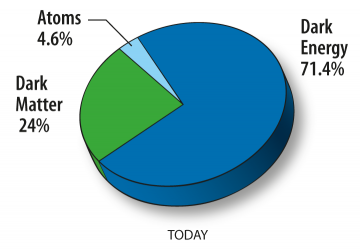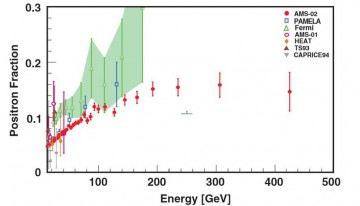
Some of the biggest cosmic mysteries are shrouded in proverbial darkness. For instance, most of the Universe’s mass is unaccounted for: All of the stuff we can directly observe in the Universe with our telescopes amounts to only 4.6 percent of the latter’s mass content. The rest is just invisible and of a completely unknown nature. Scientists have been trying to figure out the nature of this “missing” cosmic mass for nearly a century, utilising various ground-, aerial-, and space-based instruments, like the Alpha Magnetic Spectrometer, or AMS-02, a particle physics detector which is mounted on the exterior of the International Space Station. Even though a recently published study that was based on new data by the AMS showcases the solid science that is being conducted on the orbiting laboratory, it nevertheless presents no firm evidence for the existence of dark matter yet.

“Dark matter” was introduced as a term by astronomers in the early 1930s to account for the strangeness of motions that they were observing inside other galaxies. While studying how stars and interstellar gas move within galaxies and galaxy clusters, astronomers soon realised that the velocities they were observing were too high for the structures of galaxies to remain stable. If all the matter being observed and accounted for was all there was, then galaxies should have flown apart—its contents should have been hurled into the intergalactic void. There either was something flawed with the current understanding of how gravity worked on cosmic scales, or there was something else whose gravity was holding galaxies together, something that was evading observations. Thus the term “dark matter” was born. According to some theoretical models, the particles that constitute dark matter are their own anti-particles, meaning that if they would meet and collide they would annihilate while producing a stream of secondary particles including positrons (the anti-matter counterpart of electrons) in the process. If this phenomenon is indeed taking place in the Universe, these byproducts of dark matter annihilation could be detected through the study of cosmic rays, the constant flow of high-energy radiation that permeates the Universe, coming from every direction of the sky.
Even though cosmic rays have been the object of extensive study ever since they were first discovered in the early 20th century, their exact origin still remains a mystery. They are mostly composed of hydrogen and helium nuclei, and they are believed to originate from such high-energy astrophysical phenomena in the Universe like supernova explosions, colliding black holes, rapidly spinning neutron stars, and gamma-ray bursts. Yet a tiny fraction of cosmic rays (about 0.01 percent) consists of anti-matter particles like positrons. Theoretical models predict that the annihilation of dark matter particles would, among other things, cause an excess of positrons that would have a specific spectrum which would be distinguishable from that of positrons originating from other well-known astrophysical sources like pulsars and supernovae. Determining the ratio of positrons to the combined flux of positrons and electrons in high-energy cosmic rays could allow researchers to determine their exact source and whether that involves well-known astrophysical processes or the long-sought-for and elusive dark matter.
The measurement of high-energy cosmic rays and the hunt for dark matter are some of the key objects of study of the Alpha Magnetic Spectrometer module. Launched on STS-134, the space shuttle’s penultimate mission on 16 May 2011, AMS-02 was installed three days later on the S3 Truss of the orbiting laboratory from where it has been constantly operating ever since, recording more than 1,000 cosmic ray hits per second. At the heart of AMS-02 lies a large magnet which creates a uniform strong magnetic field that bends the path of the incoming charged cosmic ray particles diverting them according to the nature of each particle. A series of five different detectors measures the particles’ properties, determining their energy, velocity, charge, and coordinates inside the magnetic field, allowing the AMS to tell the difference between protons, electrons, and positrons.

The construction and operation of the state-of-the-art, 7.5-tonne orbiting particle physics detector represents a major technological achievement and is the result of an international collaboration between 60 institutes from 16 different countries in Europe, North America, and Asia. Funded by the U.S. Department of Energy, the project is managed by the Alpha Magnetic Spectrometer Project Office at NASA’s Johnson Space Center in Houston. The roots of the project trace back to the early 1990’s, when following the cancellation of the Superconducting Super Collider in 1993, Dr. Sam Ting, Nobel Laureate and principal investigator of the Alpha Magnetic Spectrometer project, proposed the construction of a simplified particle physics detector to be flown in space in order to advance research on the field of particle physics. This proposal was finally approved, leading to the lauch of a prototype version, called AMS-01, onboard the Space Shuttle Discovery on STS-91 between 2 and 12 June 1998. Even though it came up empty in its search of helium-antihelium cosmic ray particles at the energy range between 1 and 140 GeV, it nevertheless served as a proof of concept as being the first physics experiment of its kind to ever fly and successfully operate in space, allowing researchers to put an upper limit to the theoretical predictions of the antihelium flux ratio.
Based on the solid foundation that was laid by this pioneering work, the AMS-02 has, since it was first activated in May 2011, recorded more than 54 billion cosmic ray hits, providing the project’s scientists at CERN in Geneva, Switzerland, with approximately 1 GB of data per second of unprecedented precision. This huge amount of data allowed the AMS science team to announce its first results in March 2013 during a seminar at CERN, which were also published in a study that appeared in the April 2013 issue of the Physical Review Letters. Following an analysis of approximately 25 billion cosmic ray hits that had been recorded by the AMS during its first 18 months of operations, scientists had reported at the time that they had identified 6.8 million electron-positron hits in the energy range between 0.5 and 300 GeV (for comparison, the rest mass of the proton is 0.938 GeV) with an excess of approximately 400,000 positrons. By studying the power spectrum of the positrons, scientists noticed that their ratio to the combined flux of observed positrons and electrons exhibited a decrease at energies between 0.5 and 10 GeV only to rise again within the energy range between 10 and 250 GeV and steadily decline again between 20 and 250 GeV, confirming similar earlier observations by the Fermi and PAMELA space observatories. According to theory, above certain energies dark matter would annihilate without producing any secondary particles, resulting in a steep decline in the observed positron flux. Even though these first results from the AMS didn’t observe such a decline, because they were consistent with some theoretical predictions of a certain dark matter particle called the neutralino, they were eventually hyped as being evidence for the latter’s existence.
Yet these results could only be described as ambiguous at best. If the recorded positron excess was due to dark matter, then it should showcase a sudden drop beyond 250 GeV and the positron flux should display a certain directionality toward the center of the Milky Way around which most of the galaxy’s dark matter is believed to reside. The AMS data instead showed that the detected positrons were coming from every direction of the sky. All this indicated that the positron excess could well due to more mundane astrophysical sources. Clearly, more data were required before a more definite statement on the matter could be made with any certainty.

Following up on their initial findings, the AMS science team presented their latest findings in a new study that appeared on 18 September at the Physical Review Letters. In the study, the researchers report the results of their analysis of 41 billion cosmic ray hits out of the total 54 billion that the space-based particle physics detector has recorded after more than 40 months of operations, of which 10 million were identified as electron-positron hits. This new wealth of data allowed researchers to also extend the observed energy range from 350 to 500 GeV, giving them more insights into the particle physics processes of cosmic rays at ever-higher energies. The new AMS results confirmed the previous ones, by showing a distinct increase of the positron fraction around 8 GeV followed by a drop off around 275 GeV. According to the AMS science team, this pattern is representative of a new astrophysical phenomenon that could potentially be the elusive annihilation of dark matter. “This means there’s something new there,” commented Dr.Ting for the Symmetry magazine. “It’s totally unexpected.” Furthermore, the new results represent the first-ever detailed measurements of the positron fraction maximum at high energies, where positron flux ceases to increase. “Scientists have been measuring this ratio since 1964,” says Jim Siegrist, associate director of the U.S. Department of Energy’s Office of High-Energy Physics, which sponsored the AMS project “This is the first time anyone has observed this turning point.” Nevertheless, the AMS still hasn’t recorded the sudden drop-off at higher energies that is predicted by many theoretical models of dark matter. Even though the positron fraction peaks around 275 GeV, it then appears to level off without any subsequent drop off being evident. There’s nothing to preclude that from happening at even higher energies; yet the evidence gathered by the AMS so far in favor of dark matter could be seen as inconclusive at best, rendering any claims for its existence as premature. The focus of the researchers now is to collect more data on the proton-antiproton ratio and the positron fraction in the TeV energy range, which would help to indicate if the predicted positron drop-off indeed happens at higher energies and whether it’s tied to dark matter at all. “The new AMS results show unambiguously that a new source of positrons is active in the galaxy,” said Dr. Paolo Zuccon, an assistant professor of physics at the Massachusetts Institute of Technology, in a press release. “We do not know yet if these positrons are coming from dark matter collisions, or from astrophysical sources such as pulsars. But measurements are underway by AMS that may discriminate between the two hypotheses.”
Despite their apparent ambiguity regarding the potential existence of dark matter, the results to come from the AMS have nevertheless showcased the detector’s superior ability to conduct first-rate research on high-energy cosmic rays, which is a key area of study in astrophysics. “The AMS results announced today are tremendously provocative, and will drive scientists around the world to continue pursuing one of the biggest mysteries in the cosmos: dark matter,” commented Dr. Ellen Stofan, NASA’s chief scientist at Washington, D.C., following the publication of the project’s science team on 18 September. “The clear and definitive data from AMS represent the caliber of scientific discovery enabled by our unique laboratory in space, the International Space Station. Today we are one step closer to answering the fundamental questions about how our universe works, and we look forward to many more exciting twists in this developing story.”
Video Credit: NASA
Want to keep up-to-date with all things space? Be sure to “Like” AmericaSpace on Facebook and follow us on Twitter: @AmericaSpace




Leonida ti kaneis? Elpizo na eisai kala.Tha kanoniso na vrethoume kai me ta pedia.Kalo vradi.Apropo to arthro teieio!!!!!!!!!!!!!!!!!!!!!!
To arthro teleio,Elpizo na eise kALA!!!!!!!!!!!!!!!!!!